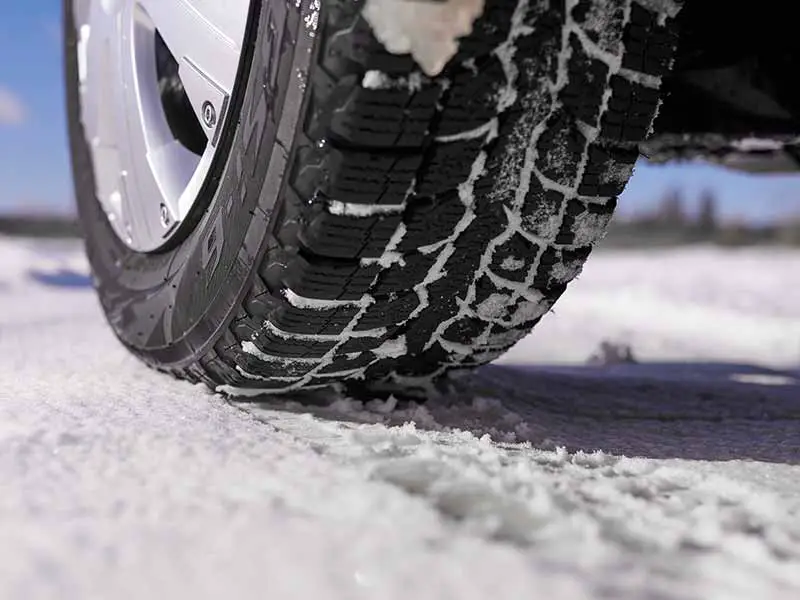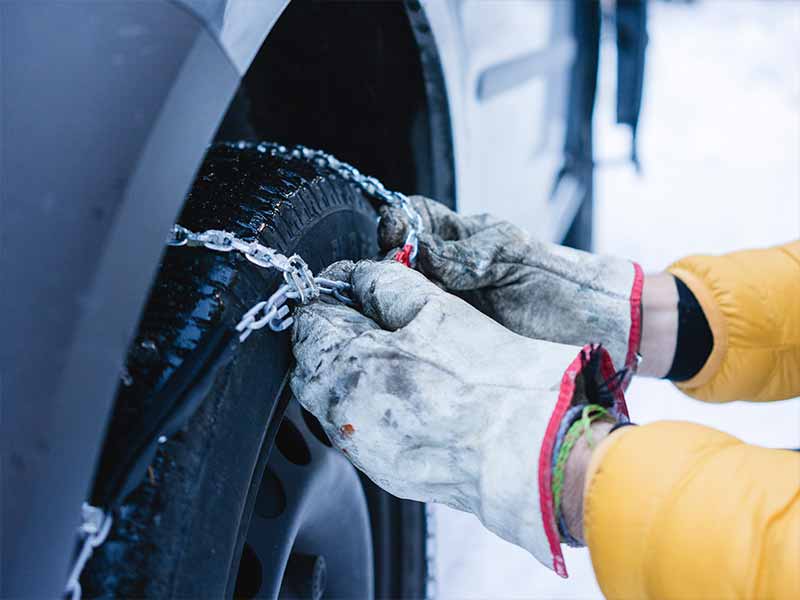Driving in the snow can be a bit like doing a waltz with ice skates on – slippery, uncertain, and a little bit nerve-wracking. But what if we told you that you have a secret weapon hiding right in your trunk, ready to turn that precarious waltz into a confident strut? Get ready to conquer those snowy roads with tire cables and chains!
Tire Cables Vs Chains
Tire cables and chains are designed to increase traction on snowy and icy roads. While tire cables are easier to install and better suited for lighter vehicles and moderate conditions, snow chains provide superior traction, making them a more suitable choice for heavier vehicles like trucks and extreme weather conditions.
In this article, we’re going to delve into the nitty-gritty of tire cables and snow chains. We’ll cover what they are, why you should use them, how to install them, and the key differences between the two. So buckle up and join us as we navigate the frosty landscape of winter driving accessories.
Let’s take a closer look.

What Are Tire Cables?
Tire cables, also known as snow cables, are a type of winter driving accessory designed to give your vehicle that extra grip when roads get slippery. They are essentially networks of steel cables arranged in a crisscross pattern. This web-like structure wraps around the tire, giving your wheels that much-needed traction on icy or snowy roads.
Unlike their cousins, the snow chains, tire cables are usually lighter and less aggressive on the road. They’re sort of the gentle giant in the family, but don’t let that fool you. They’re strong and sturdy, ready to take on that slick road!
When and Why to Use Tire Cables
Snow cables are perfect for areas where snow is moderate and roads are well maintained. They provide a good balance of improved traction and ride smoothness. If you’re thinking, “Okay, great. But when do I actually use these?” then here’s a quick rule of thumb:
- Use tire cables when there’s snow or ice on the road, but it’s not too deep.
- If you’re driving on highways or paved roads that have been plowed but are still slippery, tire cables are your go-to.
- If local laws require traction devices during winter months, tire cables can often be used to meet these requirements.
Remember, tire cables are there to make your drive safer, but they’re not a magic solution. Always drive cautiously in snowy or icy conditions.

Snow Cables
How to Install Tire Cables on Your Vehicle
Ah, the big question: “How do I get these cables on my tires?” Let’s break it down:
- Lay out the cables flat on the ground and check for any damages. If they look good, you’re ready to go.
- Position the cables over the top and sides of the tire. Make sure the metal fastener is facing outward and not towards the tire.
- Push as much of the cable as you can behind the tire.
- Move the vehicle forward or backward slightly, just enough to expose the rest of the tire.
- Fasten the cables together and ensure they are secure and evenly distributed around the tire.
A good tip is to practice installing them before you need to use them. This way, when it’s showtime, you’re ready!
Maximum Speed With Snow Cables and Their Lifespan
Tire cables may look tough, but they’re not designed for speed. Most manufacturers suggest a maximum speed of around 30 mph when you’ve got them installed. Remember, snowy and icy conditions call for slow, careful driving anyway.
As for how long they last, it depends on how often you use them and how well you maintain them. Typically, with moderate use and proper care, they can last for several winter seasons.
There you have it! A solid rundown on tire cables. They might seem a little tricky at first, but they can make a big difference when you’re navigating through a snowy day. Stay safe out there, friends!

What Are Snow Chains?
Snow chains, as the name suggests, are chains that you put on your tires to improve traction when driving in snow and ice. They are typically made from heavy-duty steel and have big, beefy links that really dig into the snow and ice. Snow chains are essentially like putting snow boots on your car. They can handle more extreme conditions than tire cables, but they also provide a rougher ride.
These chains come in a variety of sizes and styles, but they all serve the same purpose – to help your car get a grip when things get slippery!
When and Why to Use Snow Chains
Snow chains are the heavy hitters of winter driving. They’re designed to be used when conditions are more extreme, like heavy snow and ice. Here’s when you might consider using snow chains:
- When there’s a lot of snow or ice on the road, and it’s not being cleared fast enough.
- When you’re driving on steep hills or roads where extra traction is needed.
- If local laws require them. Some areas with heavy snowfall require chains during winter months.
Just like with tire cables, snow chains aren’t a substitute for careful driving. They’re just one tool in your winter-driving toolbox.

Snow Chains
How to Install Snow Chains on Your Vehicle
Ready to get your hands a little cold? Here’s a simple step-by-step process to get those chains on your tires:
- Lay the chains out flat on the ground and check for any damage or tangled links. You want them in tip-top shape before you put them on.
- Drape the chains over the tire, making sure they’re evenly distributed on all sides.
- Connect the chains together. This is typically done behind the tire and at the top of the tire. Different chains might have slightly different fasteners, so check the instructions.
- Move the vehicle slightly to adjust the chains, then tighten them up to ensure they’re secure and snug against the tire. Some chains have automatic tensioners, but for others, you might need to re-tighten them after driving a short distance.
And just like with the cables, practice makes perfect. Give it a try before the snow hits so you’re ready to roll.
Maximum Speed With Snow Chains and Their Lifespan
Snow chains are tough, but they’re not built for speed. Most manufacturers recommend a maximum speed of about 30 mph when using chains. And always remember, regardless of what you’ve got on your tires, icy and snowy conditions call for careful, slow driving.
As for how long snow chains last, it depends on a few factors like how often you use them, how well you take care of them, and the quality of the chains. But with proper care and moderate use, they should last for several winter seasons.
Tire Cables Vs Chains
We’ve gone over the ins and outs of both tire cables and snow chains. Now, it’s time to pit them against each other. “Tire Cables Vs Chains,” sounds like a blockbuster movie, right? But don’t worry, no tire accessories will be harmed in this comparison. We’re just here to help you figure out which one is right for you and your vehicle. So, let’s get to it!
Comparison of Installation Process: Ease of Putting On Tire Cables Vs Snow Chains
First things first, let’s talk about installation. Nobody likes fumbling around in the cold trying to put these things on, so ease of installation can be a big deal.
- Tire Cables: Generally, tire cables are a bit easier to put on than chains. They’re lighter, and there are less moving parts to deal with. This makes them a good choice if you’re new to the whole “winter driving accessory” scene.
- Snow Chains: Chains can be a bit trickier to put on, mostly because they’re heavier and can sometimes be a bit cumbersome. But don’t let this scare you off. With a bit of practice, putting on chains can become second nature.

Comparison of Durability: How Long Tire Cables Last Vs Snow Chains
Next up, durability. You want your winter driving accessories to last, so let’s see how cables and chains stack up.
- Tire Cables: Cables are usually made of high-strength steel, and with moderate use and proper care, they can last for several seasons. They’re a bit less robust than chains, so if they’re used on rough surfaces or at high speeds, they can wear out faster.
- Snow Chains: Chains, being the beefier option, generally last longer. They’re made to handle tougher conditions and more wear and tear. But remember, their lifespan still depends on how often you use them and how well you take care of them.
Comparison of Maximum Speed When Using Tire Cables Vs Chains
And now, let’s talk about speed. How fast can you go when you’re using cables or chains?
- Tire Cables and Chains: Interestingly, both tire cables and chains have a similar recommended maximum speed – about 30 mph. It’s important to remember this isn’t a speed you should aim for, but the top speed you should go if necessary. When driving in snowy or icy conditions, slower is always safer.
Determining the Best Choice for Different Types of Vehicles: Passenger Cars Vs Trucks
Finally, let’s talk about what might work best for your specific vehicle.
- Tire Cables: For most passenger cars and small SUVs, tire cables will likely do the trick. They’re easier to handle, cause less vibration, and are generally better suited to lighter vehicles and less severe conditions.
- Snow Chains: If you’re driving a larger vehicle like a truck, or if you’re dealing with severe conditions, chains are often the better choice. They provide superior traction and are more durable, which is perfect for heavier vehicles or tougher roads.
Resources
Below are some links you may find helpful when learning about tires
- Snow chains vs cables: Which is right for you? – NAPA
- Are snow cables better than chains? – Motor Biscuit
Final Thoughts
As we wrap up our waltz through the snowy landscape of tire cables and chains, it’s clear that while winter driving can be a slippery situation, the right equipment can turn your icy waltz into a confident strut. Whether you opt for the gentler touch of tire cables or the heavy-duty grip of snow chains will depend on your specific needs, your vehicle type, and the winter conditions you’ll face.
Safety should always be your first priority when driving in winter conditions. Tire cables and chains can give you that extra bit of traction, but it’s still essential to drive cautiously and carefully. As we’ve seen, there’s no one-size-fits-all solution, but rather a toolkit of options that can be tailored to your circumstances.
Good luck and happy motoring.





